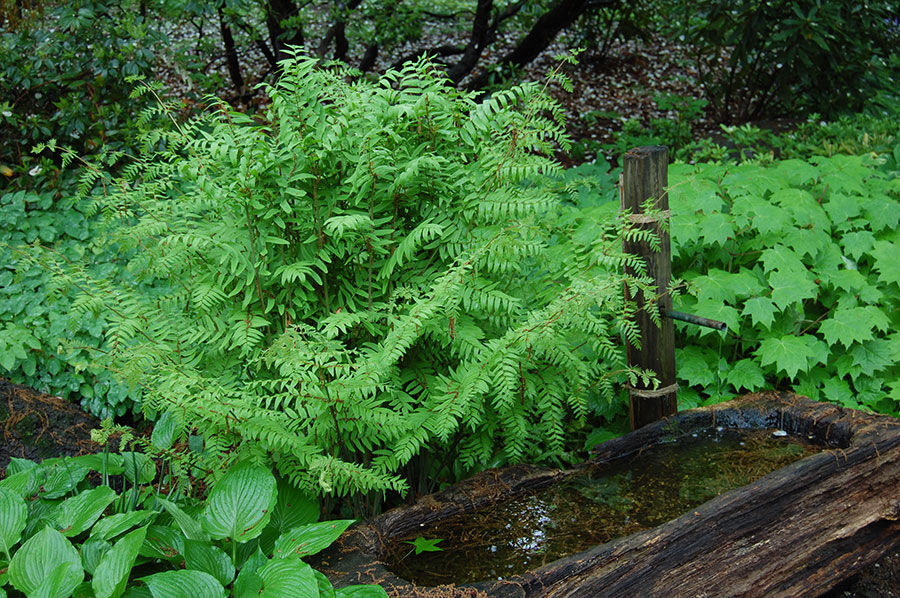Plant blindness is a term J. H. Wandersee and E. E. Schussler coined in 1999, defining how people do not recognize the importance of plants due to their lack of mobility and motion. I suspect this issue would be even more problematic if the plant did not offer attractive and colorful flowers to beckon pollinators. This is an underlying problem with the appreciation and recognition of ferns—no flowers! Fortunately for those with plant focus, they provide wonderful textures and design solutions for the garden and certainly offer a sense of permanence. For ferns, permanence is not measured in mere years or decades of living in a garden, but an incomprehensible 300 million years as some genera of ferns are among the most ancient plants on earth. Interestingly, one of the oldest fern families contains a NJ native many people have yet to 'recognize'—Osmundastrum cinnamomeum, commonly known as Cinnamon Fern.
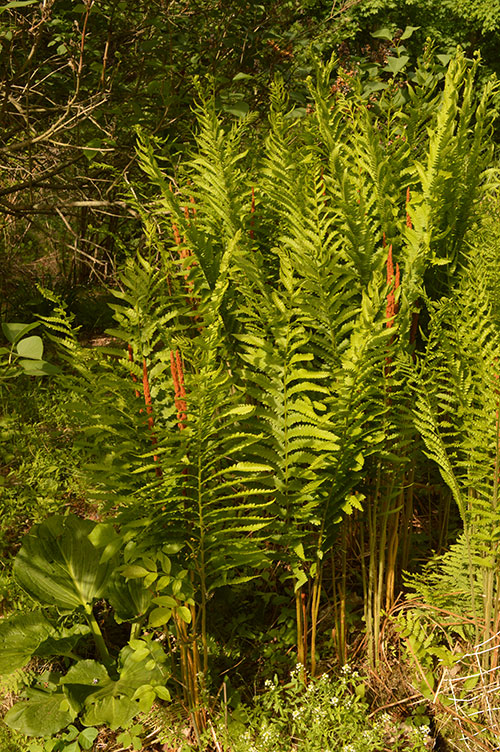
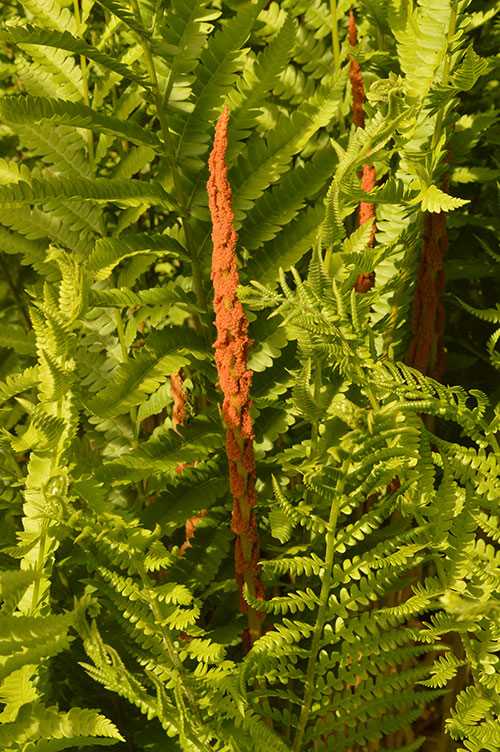
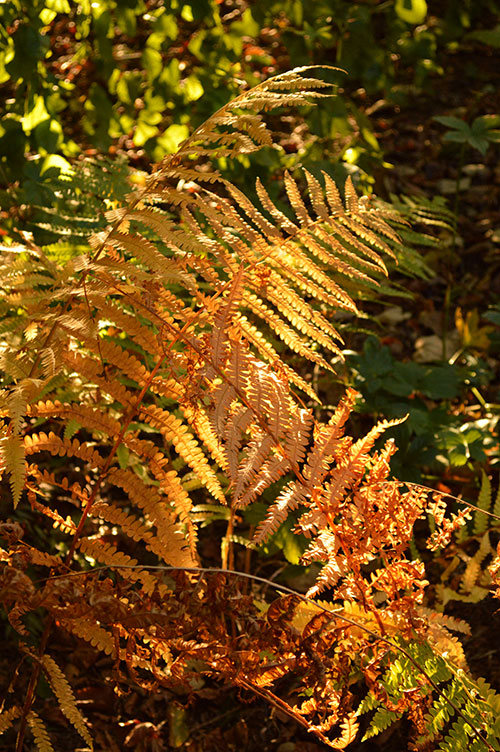
Osmundastrum cinnamomeum (Picture 1) happens to be monotypic, whereby it is the only species found within its genus. It is a member of the Royal Fern Family or Osmundaceae, which as noted is one of the oldest existing families, dating back 320 Million Years Ago (MYA). Its prolonged and stable existence has allowed it to spread over large area, made easier when the continents had merged to form the single continent of Pangea. In fact, fossils of Cinnamon Fern dating back 180 MYA from Sweden appear virtually identical to present day plants, illustrating its stability and 'permanence'. Native populations today are found in Eastern North America, Eastern Mexico, northern South America along with Siberia and parts of Eastern Asia! Up until recently Cinnamon Fern was included in the genus Osmunda, which was first coined in 1753 by the Swedish botanist Carl Linnaeus (1707–1778). Interestingly, ferns proved to be a puzzling group of plants for Linnaeus, since he organized plants by the arrangement of the pollen baring stamens and female pistil of the flower. Ferns obviously lack those organs since they reproduce by spores, not seeds. Compounding the problem, the fern life cycle with its intermediary reproductive life form of a prothalus was a mystery at the time.
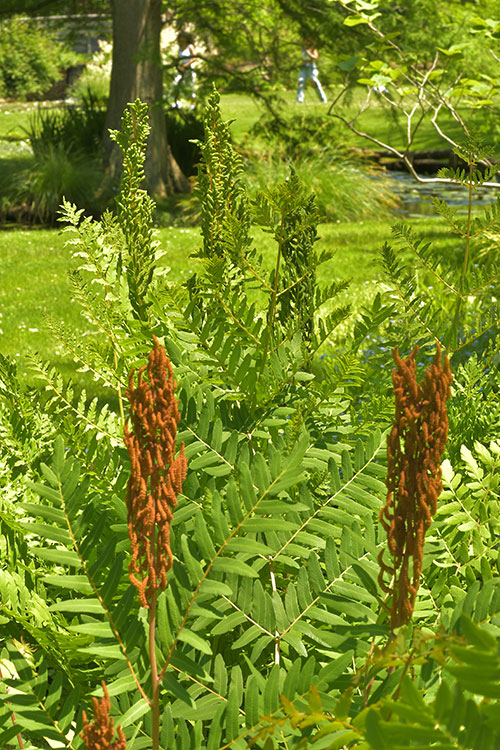
Remaining a mystery is the inspiration for the genus name. One potential inspiration could have been Bishop Osmund, a Swedish missionary who lived during the 11th Century. Or, the inspiration could have been Åsmund Kåresson, a Swedish runemaster who also lived during the 11th Century. Runes were letters in various ancient Germanic languages and Åsmund was renowned for his ability to craft high quality runestones, where the letters were deftly chiseled into stonework. Another belief is the name came from the Saxon god Osmunder, who was the Scandinavian equivalent of Thor, the Greek god of thunder. Or, there is the story of a gentleman named Osmund who hid his wife and child in a tall fern patch to keep them safe from harm. Obviously, far too many speculative stories without any firm basis for the genus name. Linnaeus was also responsible for describing and crafting the species name of cinnamomeum in 1753. The name serves as a tribute to the bright, cinnamon color of the fertile fronds and has nothing to do with the spice as one might initially suspect.
More recently, it was determined that Cinnamon Fern is uniquely different on a molecular basis from the other species listed under the genus Osmunda. In fact, its ancestry is thought to date back to the origins of the Osmundaceae family, from which the other genera and species diverged some 120 million years later. A gardener could indeed call this is a living fossil! In recognition of its older lineage, Charles N. Miller of the U. of Montana suggested adopting the name Osmundastrum for this species in 1967. The addition of 'astrum' indicates it bears a resemblance to Osmunda. Although not widely accepted at the start, its 'ancient ancestry' was eventually accepted and the new genus name was adopted. Oddly, this name is not new, but was crafted in 1847 by the Czechoslovakian botanist Karel Bořivoj Presl (1794–1852)! Clearly, his appreciation for the uniqueness of this plant was well ahead of his time!
Cinnamon Fern is a rather large fern, typically growing to 3–4' tall, although it can reach heights nearing 6'. The rhizomes expand at a glacial pace of several millimeters a year with the wiry black root mass slowly mounding up to 6" in height. For gardeners, the black fibers of the root mass have proven to be a much-desired growing medium for epiphytic plants such as Orchids. The leaves are properly called fronds and consist of a central stem or rachis along which the pinnae or leaflets are oppositely arranged. The pinnae are divided further into smaller leaflets called pinnules, giving the pinnae a very delicate appearance. Below the lowest set of pinnae, the rachis becomes more woody and is called a stipe.
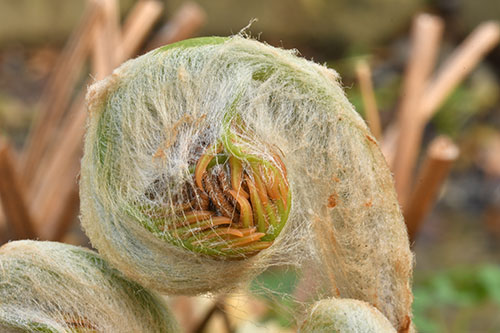
For Cinnamon Fern, the basal portions of the stipe persist for many years and serve to add volume to the mounded base of the plant. The fronds appear in two distinct forms: the spore bearing fronds call Sporophylls and the photosynthetic fronds called Trophophylls. Come spring, the strongly vertical Sporophylls emerge from the center of the root mass first, followed by the encircling lush green Trophophylls. Each Trophophyll has 12–25 pairs of pinnae along the rachis that range from 4–6" long. Each pinna is further divided into 20+ pinnules. A telltale identification feature for Cinnamon Ferns is the small tuft of orange brown fibers found on the undersides of the pinnae where they connect to the rachis. The Sporophylls reach a slightly more demure height of 2–3', and just like the Trophophylls, they sport 12–25 pairs of pinnae arranged oppositely along the rachis. In this case, the pinnae are much shorter, reaching 1–3" long and they grow in a vertical orientation alongside the rachis (Picture 2).
Initially green, the development of the cinnamon brown fibers on the pinnae allows them to assume their distinguishing cinnamon coloration. Enhancing the color, the undersides of the modified pinna contain cinnamon brown sporangia, which are the spore releasing vessels. In early May through June, depending upon the native provenance, the spores are released and distributed by wind to new locations. If conditions are proper, they rapidly grow into a small plantlet called a prothallus, which in turn gives rise to a new fern. After shedding the spores, the sporophylls whither and are no longer ornamental. Come autumn, the Trophophylls turn an attractive bronze (Picture 3) before collapsing come winter.
My experience with Cinnamon Fern actually dates back to my initial attempts at gardening in my youth. Looking to enhance a boggy area in my parent's yard, I dug and moved some of the curiously mounded root masses from a more distant location in their yard. When I sold the house some 50+ years later, those ferns were still thriving, looking much as they did when I moved them, as seen in Picture 1. Little did I know at the time, an individual plant can easily live for up to 500 years! Their only request is a moist to boggy location in full sun to partial shade. They are not tolerant of salt, so it is best not to plant them near roads that are salted heavily.
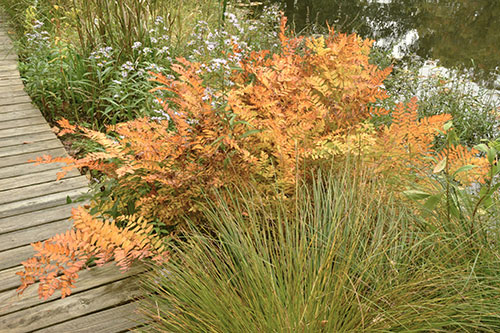
A younger cousin of Cinnamon Fern is Osmunda regalis, the Royal Fern (Pictures 4 and 7). Once again described by Linnaeus in 1753, it is also native to all 7 continents around the world. Unlike the dimorphic leaves of Cinnamon Fern, whereby there are uniquely different reproductive and photosynthetic leaves, the foliage of Royal Fern is monomorphic, in which there is one leaf with the reproductive pinnae appearing at the tip of the rachis (Picture 4). This spore bearing cinnamon brown pinnae appear much like a crown and provided the inspiration for both the common name and the species epithet! The photosynthetic pinnae have far more distinct individual pinnules, providing a coarser appearance than its 'older' cousin. The fronds are also more arching and not as stiffly upright as displayed by its cousin.
The rhizome of Royal Fern is also slow to expand and develops a similar mounded form, once again incorporating the woody bases of the stipes. One of the pleasures is watching the fronds grow and expand in spring. When the fronds first appear, they resemble the scroll at the tip of a fiddle's fingerboard or the top of a bishop's staff, affectionately giving rise to their common names of fiddleheads or crosiers. The frond grows through the uncurling and lengthening of the fiddlehead, a process called circinate vernation. The formation of the fiddlehead is actually a defensive mechanism whereby the immature leaves are protected within the coil as well as by the predominant weblike fibers (Picture 5). The fiddlehead actually uncurls through water pressure gradients caused through photosynthesis. Even before the photosynthetic pinnae of the fronds fully appear, the chloroplasts in the leafy young stipules at the base of the stipe and in the coiled rachis produce sugars. These sugars accumulate in the rachis and as this concentration of sugars in the central 'stem' increases, it causes water to rise into the rachis. This rising water causes water pressure to increase causing the fiddlehead to unfurl.
For those who enjoy studying objects of incredible detail, the crosiers are heavily covered in a network of fibers, which are shed as the frond continues to unfurl. For Cinnamon Fern, the fibers are cinnamon colored while for the Royal Fern they are white, although the fibers are not present in every plant. Not only are the fibers rather ornamental, they serve to protect the developing frond from late frosts and possible predation. The selection known as 'Purpurascens’ has reddish-purple pinnae when young, even when compressed within a fiddlehead as seen in Picture 5. In addition, these fibers are actually prized by Hummingbirds for making their nests! Like its cousin, Royal Fern appreciates permanently moist to wet sites in full sun to light shade and they too are extremely long lived. Also like its cousin, they are resistant to deer browse!
I suspect ferns and their many details will remain 'blind' to most non-gardeners. Yet, for gardeners, it is a group whose importance deserves to be recognized for their many benefits they bring to the garden. Royal and Cinnamon Ferns in particular are tremendous assets for color and texture in the moist or bog garden. They have certainly proven the test of time and unbeknownst to many, they truly are an example of antiquity in our midst!
